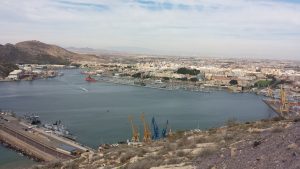Topography and urban development of Carthagonova
Portus Limen Seminar Series
The 23rd february at the University of Southampton
Topography and urban development of Carthagonova: ARQUEOTOPOS Project
IP: Sebastian Ramallo Asensio – Murcia University. HAR2011-29330
By Felipe Cerezo Andreo – Universidad de Murcia – felipe.cerezo@um.es

The ARQUETOPOS project, led by Professor Sebastian Ramallo of the University of Murcia, seeks to study the paleo-topography of the Mediterranean port of Carthago-Nova (Cartagena). This initiative is composed of a multidisciplinary team that includes geologists, geomorphologists, topographers, archaeologists and palynologists who are attempting to reconstruct the evolution of the maritime landscape during the Holocene. Over the past few years, new archaeological evidence, such as the theatre and forum and the remains on the Molinete Hill (the ancient Arx Asdrubalis) have confirmed that Carthgo-Nova was one of the most important Roman ports in the western Mediterranean. The ARQUETOPOS project is applying geo-archaeological methodologies to gain a range of new data to better understand its topographical development throughout antiquity. The use of geoarcheological techniques, geomorphological analysis, underwater survey and excavation, archeological data and the application of archeometrical approaches has made it possible for us to put forward new ideas about the development of the harbour, the associated coastal lagoon and the city itself. In particular, it has shed new light upon the processes that led to the infilling of the lagoon, the human intervention that was undertaken to try and control this process and the relative sea level change – all of which were factors that may have regulated the rise or fall of urban life in various ways. This seminar is a preliminary presentation of the project methodology and results.

